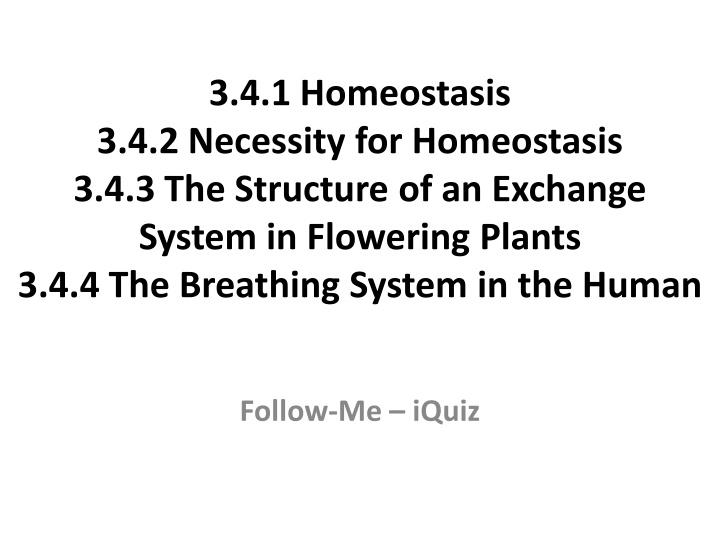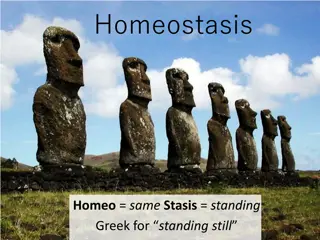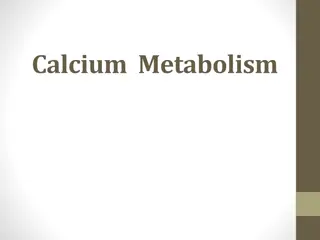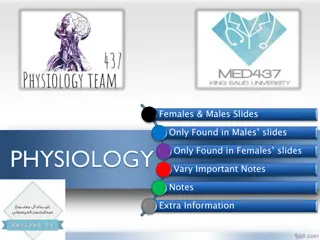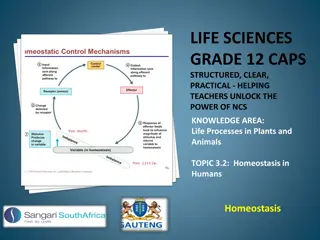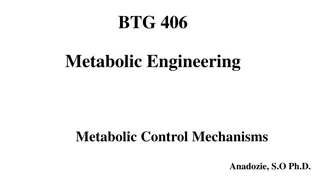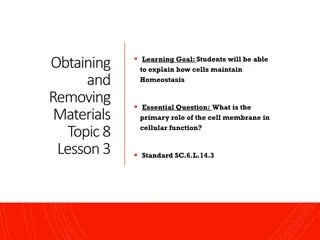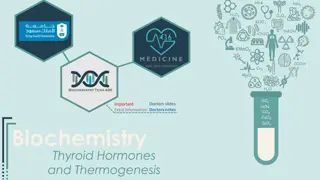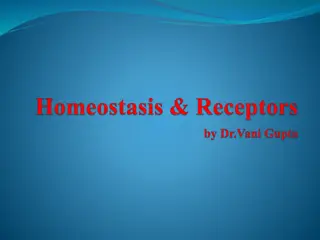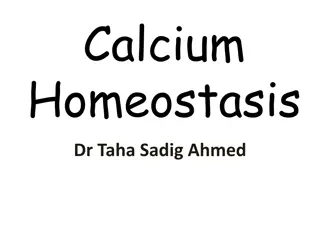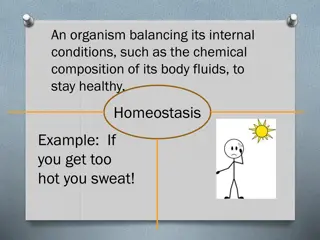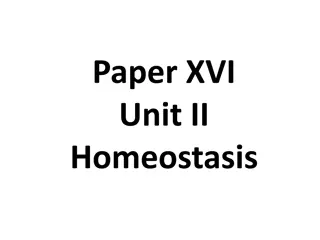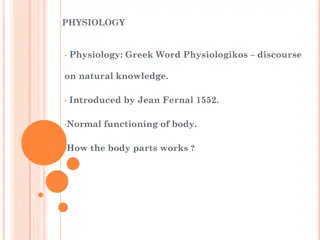Homeostasis: Importance and Systems
Homeostasis is vital for maintaining internal balance in biological systems. Explore the necessity of homeostasis in plants and humans, including exchange systems and breathing mechanisms. Learn about the absorption of glucose, gas exchange, and regulatory processes that keep organisms functioning optimally.
Download Presentation

Please find below an Image/Link to download the presentation.
The content on the website is provided AS IS for your information and personal use only. It may not be sold, licensed, or shared on other websites without obtaining consent from the author.If you encounter any issues during the download, it is possible that the publisher has removed the file from their server.
You are allowed to download the files provided on this website for personal or commercial use, subject to the condition that they are used lawfully. All files are the property of their respective owners.
The content on the website is provided AS IS for your information and personal use only. It may not be sold, licensed, or shared on other websites without obtaining consent from the author.
E N D
Presentation Transcript
3.4.1 Homeostasis 3.4.2 Necessity for Homeostasis 3.4.3 The Structure of an Exchange System in Flowering Plants 3.4.4 The Breathing System in the Human Follow-Me iQuiz
Q. What is homeostasis? Absorption or release of glucose; Heat generation CO2; Light intensity; Potassium ions; Water Maintaining a constant internal environment Absorption or release of glucose; Heat generation CO2; Light intensity; Potassium ions; Water Maintaining a constant internal environment Air; Water vapour; O2; CO2; N2 Contracts, lowers and increases volume of thorax Make sound Air; Water vapour; O2; CO2; N2 Contracts, lowers and increases volume of thorax Make sound Allow exchange of gases; Transpiration Controls stomatal size; Controls passage of gases Osmosis Allow exchange of gases; Transpiration Controls stomatal size; Controls passage of gases Osmosis Allows normal metabolic activities; Keeps temperature suitable for enzyme reactions Diffusion Oxygen Allows normal metabolic activities; Keeps temperature suitable for enzyme reactions Diffusion Oxygen Exchange of gases CO2 out, O2 in by diffusion Oxygen; Water vapour; Carbon dioxide; Nitrogen By oxyhaemoglobin Exchange of gases CO2 out, O2 in by diffusion Oxygen; Water vapour; Carbon dioxide; Nitrogen By oxyhaemoglobin Capillary network; Moist surface; Thin walled; Elastic wall; Large surface area; One cell thick Capillary network; Moist surface; Thin walled; Elastic wall; Large surface area; One cell thick Excretion of water or CO2; Release of heat Stomata Excretion of water or CO2; Release of heat Excretion or reabsorption of water; Excretion of salts; Reabsorption of salts Stomata Excretion or reabsorption of water; Excretion of salts; Reabsorption of salts Their motion carries trapped dirt particles and bacteria upwards to the glottis Their motion carries trapped dirt particles and bacteria upwards to the glottis Chloroplasts Chloroplasts Close off trachea Trachea Lenticels Close off trachea Trachea Lenticels
CONGRATULATIONS Please CLICK on THIS BOX for the Next Question Please CLICK on THIS BOX for the Next Question
Q. Note one reason why homeostasis is important in the human body. Absorption or release of glucose; Heat generation CO2; Light intensity; Potassium ions; Water Maintaining a constant internal environment Absorption or release of glucose; Heat generation CO2; Light intensity; Potassium ions; Water Maintaining a constant internal environment Air; Water vapour; O2; CO2; N2 Contracts, lowers and increases volume of thorax Make sound Air; Water vapour; O2; CO2; N2 Contracts, lowers and increases volume of thorax Make sound Allow exchange of gases; Transpiration Controls stomatal size; Controls passage of gases Osmosis Allow exchange of gases; Transpiration Controls stomatal size; Controls passage of gases Osmosis Allows normal metabolic activities; Keeps temperature suitable for enzyme reactions Diffusion Oxygen Allows normal metabolic activities; Keeps temperature suitable for enzyme reactions Diffusion Oxygen Exchange of gases CO2 out, O2 in by diffusion Oxygen; Water vapour; Carbon dioxide; Nitrogen By oxyhaemoglobin Exchange of gases CO2 out, O2 in by diffusion Oxygen; Water vapour; Carbon dioxide; Nitrogen By oxyhaemoglobin Capillary network; Moist surface; Thin walled; Elastic wall; Large surface area; One cell thick Capillary network; Moist surface; Thin walled; Elastic wall; Large surface area; One cell thick Excretion of water or CO2; Release of heat Stomata Excretion of water or CO2; Release of heat Excretion or reabsorption of water; Excretion of salts; Reabsorption of salts Stomata Excretion or reabsorption of water; Excretion of salts; Reabsorption of salts Their motion carries trapped dirt particles and bacteria upwards to the glottis Their motion carries trapped dirt particles and bacteria upwards to the glottis Chloroplasts Chloroplasts Close off trachea Trachea Lenticels Close off trachea Trachea Lenticels
CONGRATULATIONS Please CLICK on THIS BOX for the Next Question Please CLICK on THIS BOX for the Next Question
Q. What is the function of the stomata of the leaf? Absorption or release of glucose; Heat generation CO2; Light intensity; Potassium ions; Water Maintaining a constant internal environment Absorption or release of glucose; Heat generation CO2; Light intensity; Potassium ions; Water Maintaining a constant internal environment Air; Water vapour; O2; CO2; N2 Contracts, lowers and increases volume of thorax Make sound Air; Water vapour; O2; CO2; N2 Contracts, lowers and increases volume of thorax Make sound Allow exchange of gases; Transpiration Controls stomatal size; Controls passage of gases Osmosis Allow exchange of gases; Transpiration Controls stomatal size; Controls passage of gases Osmosis Allows normal metabolic activities; Keeps temperature suitable for enzyme reactions Diffusion Oxygen Allows normal metabolic activities; Keeps temperature suitable for enzyme reactions Diffusion Oxygen Exchange of gases CO2 out, O2 in by diffusion Oxygen; Water vapour; Carbon dioxide; Nitrogen By oxyhaemoglobin Exchange of gases CO2 out, O2 in by diffusion Oxygen; Water vapour; Carbon dioxide; Nitrogen By oxyhaemoglobin Capillary network; Moist surface; Thin walled; Elastic wall; Large surface area; One cell thick Capillary network; Moist surface; Thin walled; Elastic wall; Large surface area; One cell thick Excretion of water or CO2; Release of heat Stomata Excretion of water or CO2; Release of heat Excretion or reabsorption of water; Excretion of salts; Reabsorption of salts Stomata Excretion or reabsorption of water; Excretion of salts; Reabsorption of salts Their motion carries trapped dirt particles and bacteria upwards to the glottis Their motion carries trapped dirt particles and bacteria upwards to the glottis Chloroplasts Chloroplasts Close off trachea Trachea Lenticels Close off trachea Trachea Lenticels
CONGRATULATIONS Please CLICK on THIS BOX for the Next Question Please CLICK on THIS BOX for the Next Question
Q. Name the structures in plant cells in which photosynthesis occurs. Absorption or release of glucose; Heat generation CO2; Light intensity; Potassium ions; Water Maintaining a constant internal environment Absorption or release of glucose; Heat generation CO2; Light intensity; Potassium ions; Water Maintaining a constant internal environment Air; Water vapour; O2; CO2; N2 Contracts, lowers and increases volume of thorax Make sound Air; Water vapour; O2; CO2; N2 Contracts, lowers and increases volume of thorax Make sound Allow exchange of gases; Transpiration Controls stomatal size; Controls passage of gases Osmosis Allow exchange of gases; Transpiration Controls stomatal size; Controls passage of gases Osmosis Allows normal metabolic activities; Keeps temperature suitable for enzyme reactions Diffusion Oxygen Allows normal metabolic activities; Keeps temperature suitable for enzyme reactions Diffusion Oxygen Exchange of gases CO2 out, O2 in by diffusion Oxygen; Water vapour; Carbon dioxide; Nitrogen By oxyhaemoglobin Exchange of gases CO2 out, O2 in by diffusion Oxygen; Water vapour; Carbon dioxide; Nitrogen By oxyhaemoglobin Capillary network; Moist surface; Thin walled; Elastic wall; Large surface area; One cell thick Capillary network; Moist surface; Thin walled; Elastic wall; Large surface area; One cell thick Excretion of water or CO2; Release of heat Stomata Excretion of water or CO2; Release of heat Excretion or reabsorption of water; Excretion of salts; Reabsorption of salts Stomata Excretion or reabsorption of water; Excretion of salts; Reabsorption of salts Their motion carries trapped dirt particles and bacteria upwards to the glottis Their motion carries trapped dirt particles and bacteria upwards to the glottis Chloroplasts Chloroplasts Close off trachea Trachea Lenticels Close off trachea Trachea Lenticels
CONGRATULATIONS Please CLICK on THIS BOX for the Next Question Please CLICK on THIS BOX for the Next Question
Q. Name a gas that leaves the leaf at the stoma(ta). Absorption or release of glucose; Heat generation CO2; Light intensity; Potassium ions; Water Maintaining a constant internal environment Absorption or release of glucose; Heat generation CO2; Light intensity; Potassium ions; Water Maintaining a constant internal environment Air; Water vapour; O2; CO2; N2 Contracts, lowers and increases volume of thorax Make sound Air; Water vapour; O2; CO2; N2 Contracts, lowers and increases volume of thorax Make sound Allow exchange of gases; Transpiration Controls stomatal size; Controls passage of gases Osmosis Allow exchange of gases; Transpiration Controls stomatal size; Controls passage of gases Osmosis Allows normal metabolic activities; Keeps temperature suitable for enzyme reactions Diffusion Oxygen Allows normal metabolic activities; Keeps temperature suitable for enzyme reactions Diffusion Oxygen Exchange of gases CO2 out, O2 in by diffusion Oxygen; Water vapour; Carbon dioxide; Nitrogen By oxyhaemoglobin Exchange of gases CO2 out, O2 in by diffusion Oxygen; Water vapour; Carbon dioxide; Nitrogen By oxyhaemoglobin Capillary network; Moist surface; Thin walled; Elastic wall; Large surface area; One cell thick Capillary network; Moist surface; Thin walled; Elastic wall; Large surface area; One cell thick Excretion of water or CO2; Release of heat Stomata Excretion of water or CO2; Release of heat Excretion or reabsorption of water; Excretion of salts; Reabsorption of salts Stomata Excretion or reabsorption of water; Excretion of salts; Reabsorption of salts Their motion carries trapped dirt particles and bacteria upwards to the glottis Their motion carries trapped dirt particles and bacteria upwards to the glottis Chloroplasts Chloroplasts Close off trachea Trachea Lenticels Close off trachea Trachea Lenticels
CONGRATULATIONS Please CLICK on THIS BOX for the Next Question Please CLICK on THIS BOX for the Next Question
Q. How do the nephrons of the kidneys contribute to homeostasis? Absorption or release of glucose; Heat generation CO2; Light intensity; Potassium ions; Water Maintaining a constant internal environment Absorption or release of glucose; Heat generation CO2; Light intensity; Potassium ions; Water Maintaining a constant internal environment Air; Water vapour; O2; CO2; N2 Contracts, lowers and increases volume of thorax Make sound Air; Water vapour; O2; CO2; N2 Contracts, lowers and increases volume of thorax Make sound Allow exchange of gases; Transpiration Controls stomatal size; Controls passage of gases Osmosis Allow exchange of gases; Transpiration Controls stomatal size; Controls passage of gases Osmosis Allows normal metabolic activities; Keeps temperature suitable for enzyme reactions Diffusion Oxygen Allows normal metabolic activities; Keeps temperature suitable for enzyme reactions Diffusion Oxygen Exchange of gases CO2 out, O2 in by diffusion Oxygen; Water vapour; Carbon dioxide; Nitrogen By oxyhaemoglobin Exchange of gases CO2 out, O2 in by diffusion Oxygen; Water vapour; Carbon dioxide; Nitrogen By oxyhaemoglobin Capillary network; Moist surface; Thin walled; Elastic wall; Large surface area; One cell thick Capillary network; Moist surface; Thin walled; Elastic wall; Large surface area; One cell thick Excretion of water or CO2; Release of heat Stomata Excretion of water or CO2; Release of heat Excretion or reabsorption of water; Excretion of salts; Reabsorption of salts Stomata Excretion or reabsorption of water; Excretion of salts; Reabsorption of salts Their motion carries trapped dirt particles and bacteria upwards to the glottis Their motion carries trapped dirt particles and bacteria upwards to the glottis Chloroplasts Chloroplasts Close off trachea Trachea Lenticels Close off trachea Trachea Lenticels
CONGRATULATIONS Please CLICK on THIS BOX for the Next Question Please CLICK on THIS BOX for the Next Question
Q. Name a factor that influences the diameter of the stoma(ta). Absorption or release of glucose; Heat generation CO2; Light intensity; Potassium ions; Water Maintaining a constant internal environment Absorption or release of glucose; Heat generation CO2; Light intensity; Potassium ions; Water Maintaining a constant internal environment Air; Water vapour; O2; CO2; N2 Contracts, lowers and increases volume of thorax Make sound Air; Water vapour; O2; CO2; N2 Contracts, lowers and increases volume of thorax Make sound Allow exchange of gases; Transpiration Controls stomatal size; Controls passage of gases Osmosis Allow exchange of gases; Transpiration Controls stomatal size; Controls passage of gases Osmosis Allows normal metabolic activities; Keeps temperature suitable for enzyme reactions Diffusion Oxygen Allows normal metabolic activities; Keeps temperature suitable for enzyme reactions Diffusion Oxygen Exchange of gases CO2 out, O2 in by diffusion Oxygen; Water vapour; Carbon dioxide; Nitrogen By oxyhaemoglobin Exchange of gases CO2 out, O2 in by diffusion Oxygen; Water vapour; Carbon dioxide; Nitrogen By oxyhaemoglobin Capillary network; Moist surface; Thin walled; Elastic wall; Large surface area; One cell thick Capillary network; Moist surface; Thin walled; Elastic wall; Large surface area; One cell thick Excretion of water or CO2; Release of heat Stomata Excretion of water or CO2; Release of heat Excretion or reabsorption of water; Excretion of salts; Reabsorption of salts Stomata Excretion or reabsorption of water; Excretion of salts; Reabsorption of salts Their motion carries trapped dirt particles and bacteria upwards to the glottis Their motion carries trapped dirt particles and bacteria upwards to the glottis Chloroplasts Chloroplasts Close off trachea Trachea Lenticels Close off trachea Trachea Lenticels
CONGRATULATIONS Please CLICK on THIS BOX for the Next Question Please CLICK on THIS BOX for the Next Question
Q. Give a function of the guard cell. Absorption or release of glucose; Heat generation CO2; Light intensity; Potassium ions; Water Maintaining a constant internal environment Absorption or release of glucose; Heat generation CO2; Light intensity; Potassium ions; Water Maintaining a constant internal environment Air; Water vapour; O2; CO2; N2 Contracts, lowers and increases volume of thorax Make sound Air; Water vapour; O2; CO2; N2 Contracts, lowers and increases volume of thorax Make sound Allow exchange of gases; Transpiration Controls stomatal size; Controls passage of gases Osmosis Allow exchange of gases; Transpiration Controls stomatal size; Controls passage of gases Osmosis Allows normal metabolic activities; Keeps temperature suitable for enzyme reactions Diffusion Oxygen Allows normal metabolic activities; Keeps temperature suitable for enzyme reactions Diffusion Oxygen Exchange of gases CO2 out, O2 in by diffusion Oxygen; Water vapour; Carbon dioxide; Nitrogen By oxyhaemoglobin Exchange of gases CO2 out, O2 in by diffusion Oxygen; Water vapour; Carbon dioxide; Nitrogen By oxyhaemoglobin Capillary network; Moist surface; Thin walled; Elastic wall; Large surface area; One cell thick Capillary network; Moist surface; Thin walled; Elastic wall; Large surface area; One cell thick Excretion of water or CO2; Release of heat Stomata Excretion of water or CO2; Release of heat Excretion or reabsorption of water; Excretion of salts; Reabsorption of salts Stomata Excretion or reabsorption of water; Excretion of salts; Reabsorption of salts Their motion carries trapped dirt particles and bacteria upwards to the glottis Their motion carries trapped dirt particles and bacteria upwards to the glottis Chloroplasts Chloroplasts Close off trachea Trachea Lenticels Close off trachea Trachea Lenticels
CONGRATULATIONS Please CLICK on THIS BOX for the Next Question Please CLICK on THIS BOX for the Next Question
Q. Where do cilia occur in the breathing system? Absorption or release of glucose; Heat generation CO2; Light intensity; Potassium ions; Water Maintaining a constant internal environment Absorption or release of glucose; Heat generation CO2; Light intensity; Potassium ions; Water Maintaining a constant internal environment Air; Water vapour; O2; CO2; N2 Contracts, lowers and increases volume of thorax Make sound Air; Water vapour; O2; CO2; N2 Contracts, lowers and increases volume of thorax Make sound Allow exchange of gases; Transpiration Controls stomatal size; Controls passage of gases Osmosis Allow exchange of gases; Transpiration Controls stomatal size; Controls passage of gases Osmosis Allows normal metabolic activities; Keeps temperature suitable for enzyme reactions Diffusion Oxygen Allows normal metabolic activities; Keeps temperature suitable for enzyme reactions Diffusion Oxygen Exchange of gases CO2 out, O2 in by diffusion Oxygen; Water vapour; Carbon dioxide; Nitrogen By oxyhaemoglobin Exchange of gases CO2 out, O2 in by diffusion Oxygen; Water vapour; Carbon dioxide; Nitrogen By oxyhaemoglobin Capillary network; Moist surface; Thin walled; Elastic wall; Large surface area; One cell thick Capillary network; Moist surface; Thin walled; Elastic wall; Large surface area; One cell thick Excretion of water or CO2; Release of heat Stomata Excretion of water or CO2; Release of heat Excretion or reabsorption of water; Excretion of salts; Reabsorption of salts Stomata Excretion or reabsorption of water; Excretion of salts; Reabsorption of salts Their motion carries trapped dirt particles and bacteria upwards to the glottis Their motion carries trapped dirt particles and bacteria upwards to the glottis Chloroplasts Chloroplasts Close off trachea Trachea Lenticels Close off trachea Trachea Lenticels
CONGRATULATIONS Please CLICK on THIS BOX for the Next Question Please CLICK on THIS BOX for the Next Question
Q. State precisely the events that take place in the alveoli. Absorption or release of glucose; Heat generation CO2; Light intensity; Potassium ions; Water Maintaining a constant internal environment Absorption or release of glucose; Heat generation CO2; Light intensity; Potassium ions; Water Maintaining a constant internal environment Air; Water vapour; O2; CO2; N2 Contracts, lowers and increases volume of thorax Make sound Air; Water vapour; O2; CO2; N2 Contracts, lowers and increases volume of thorax Make sound Allow exchange of gases; Transpiration Controls stomatal size; Controls passage of gases Osmosis Allow exchange of gases; Transpiration Controls stomatal size; Controls passage of gases Osmosis Allows normal metabolic activities; Keeps temperature suitable for enzyme reactions Diffusion Oxygen Allows normal metabolic activities; Keeps temperature suitable for enzyme reactions Diffusion Oxygen Exchange of gases CO2 out, O2 in by diffusion Oxygen; Water vapour; Carbon dioxide; Nitrogen By oxyhaemoglobin Exchange of gases CO2 out, O2 in by diffusion Oxygen; Water vapour; Carbon dioxide; Nitrogen By oxyhaemoglobin Capillary network; Moist surface; Thin walled; Elastic wall; Large surface area; One cell thick Capillary network; Moist surface; Thin walled; Elastic wall; Large surface area; One cell thick Excretion of water or CO2; Release of heat Stomata Excretion of water or CO2; Release of heat Excretion or reabsorption of water; Excretion of salts; Reabsorption of salts Stomata Excretion or reabsorption of water; Excretion of salts; Reabsorption of salts Their motion carries trapped dirt particles and bacteria upwards to the glottis Their motion carries trapped dirt particles and bacteria upwards to the glottis Chloroplasts Chloroplasts Close off trachea Trachea Lenticels Close off trachea Trachea Lenticels
CONGRATULATIONS Please CLICK on THIS BOX for the Next Question Please CLICK on THIS BOX for the Next Question
Q. State the function of the epiglottis. Absorption or release of glucose; Heat generation CO2; Light intensity; Potassium ions; Water Maintaining a constant internal environment Absorption or release of glucose; Heat generation CO2; Light intensity; Potassium ions; Water Maintaining a constant internal environment Air; Water vapour; O2; CO2; N2 Contracts, lowers and increases volume of thorax Make sound Air; Water vapour; O2; CO2; N2 Contracts, lowers and increases volume of thorax Make sound Allow exchange of gases; Transpiration Controls stomatal size; Controls passage of gases Osmosis Allow exchange of gases; Transpiration Controls stomatal size; Controls passage of gases Osmosis Allows normal metabolic activities; Keeps temperature suitable for enzyme reactions Diffusion Oxygen Allows normal metabolic activities; Keeps temperature suitable for enzyme reactions Diffusion Oxygen Exchange of gases CO2 out, O2 in by diffusion Oxygen; Water vapour; Carbon dioxide; Nitrogen By oxyhaemoglobin Exchange of gases CO2 out, O2 in by diffusion Oxygen; Water vapour; Carbon dioxide; Nitrogen By oxyhaemoglobin Capillary network; Moist surface; Thin walled; Elastic wall; Large surface area; One cell thick Capillary network; Moist surface; Thin walled; Elastic wall; Large surface area; One cell thick Excretion of water or CO2; Release of heat Stomata Excretion of water or CO2; Release of heat Excretion or reabsorption of water; Excretion of salts; Reabsorption of salts Stomata Excretion or reabsorption of water; Excretion of salts; Reabsorption of salts Their motion carries trapped dirt particles and bacteria upwards to the glottis Their motion carries trapped dirt particles and bacteria upwards to the glottis Chloroplasts Chloroplasts Close off trachea Trachea Lenticels Close off trachea Trachea Lenticels
CONGRATULATIONS Please CLICK on THIS BOX for the Next Question Please CLICK on THIS BOX for the Next Question
Q. Name the process involved in the passage of gas between the alveolus and the blood. Absorption or release of glucose; Heat generation CO2; Light intensity; Potassium ions; Water Maintaining a constant internal environment Absorption or release of glucose; Heat generation CO2; Light intensity; Potassium ions; Water Maintaining a constant internal environment Air; Water vapour; O2; CO2; N2 Contracts, lowers and increases volume of thorax Make sound Air; Water vapour; O2; CO2; N2 Contracts, lowers and increases volume of thorax Make sound Allow exchange of gases; Transpiration Controls stomatal size; Controls passage of gases Osmosis Allow exchange of gases; Transpiration Controls stomatal size; Controls passage of gases Osmosis Allows normal metabolic activities; Keeps temperature suitable for enzyme reactions Diffusion Oxygen Allows normal metabolic activities; Keeps temperature suitable for enzyme reactions Diffusion Oxygen Exchange of gases CO2 out, O2 in by diffusion Oxygen; Water vapour; Carbon dioxide; Nitrogen By oxyhaemoglobin Exchange of gases CO2 out, O2 in by diffusion Oxygen; Water vapour; Carbon dioxide; Nitrogen By oxyhaemoglobin Capillary network; Moist surface; Thin walled; Elastic wall; Large surface area; One cell thick Capillary network; Moist surface; Thin walled; Elastic wall; Large surface area; One cell thick Excretion of water or CO2; Release of heat Stomata Excretion of water or CO2; Release of heat Excretion or reabsorption of water; Excretion of salts; Reabsorption of salts Stomata Excretion or reabsorption of water; Excretion of salts; Reabsorption of salts Their motion carries trapped dirt particles and bacteria upwards to the glottis Their motion carries trapped dirt particles and bacteria upwards to the glottis Chloroplasts Chloroplasts Close off trachea Trachea Lenticels Close off trachea Trachea Lenticels
CONGRATULATIONS Please CLICK on THIS BOX for the Next Question Please CLICK on THIS BOX for the Next Question
Q. How does the liver contribute to homeostasis? Absorption or release of glucose; Heat generation CO2; Light intensity; Potassium ions; Water Maintaining a constant internal environment Absorption or release of glucose; Heat generation CO2; Light intensity; Potassium ions; Water Maintaining a constant internal environment Air; Water vapour; O2; CO2; N2 Contracts, lowers and increases volume of thorax Make sound Air; Water vapour; O2; CO2; N2 Contracts, lowers and increases volume of thorax Make sound Allow exchange of gases; Transpiration Controls stomatal size; Controls passage of gases Osmosis Allow exchange of gases; Transpiration Controls stomatal size; Controls passage of gases Osmosis Allows normal metabolic activities; Keeps temperature suitable for enzyme reactions Diffusion Oxygen Allows normal metabolic activities; Keeps temperature suitable for enzyme reactions Diffusion Oxygen Exchange of gases CO2 out, O2 in by diffusion Oxygen; Water vapour; Carbon dioxide; Nitrogen By oxyhaemoglobin Exchange of gases CO2 out, O2 in by diffusion Oxygen; Water vapour; Carbon dioxide; Nitrogen By oxyhaemoglobin Capillary network; Moist surface; Thin walled; Elastic wall; Large surface area; One cell thick Capillary network; Moist surface; Thin walled; Elastic wall; Large surface area; One cell thick Excretion of water or CO2; Release of heat Stomata Excretion of water or CO2; Release of heat Excretion or reabsorption of water; Excretion of salts; Reabsorption of salts Stomata Excretion or reabsorption of water; Excretion of salts; Reabsorption of salts Their motion carries trapped dirt particles and bacteria upwards to the glottis Their motion carries trapped dirt particles and bacteria upwards to the glottis Chloroplasts Chloroplasts Close off trachea Trachea Lenticels Close off trachea Trachea Lenticels
CONGRATULATIONS Please CLICK on THIS BOX for the Next Question Please CLICK on THIS BOX for the Next Question
Q. Name the apertures in stems that are equivalent to stomata. Absorption or release of glucose; Heat generation CO2; Light intensity; Potassium ions; Water Maintaining a constant internal environment Absorption or release of glucose; Heat generation CO2; Light intensity; Potassium ions; Water Maintaining a constant internal environment Air; Water vapour; O2; CO2; N2 Contracts, lowers and increases volume of thorax Make sound Air; Water vapour; O2; CO2; N2 Contracts, lowers and increases volume of thorax Make sound Allow exchange of gases; Transpiration Controls stomatal size; Controls passage of gases Osmosis Allow exchange of gases; Transpiration Controls stomatal size; Controls passage of gases Osmosis Allows normal metabolic activities; Keeps temperature suitable for enzyme reactions Diffusion Oxygen Allows normal metabolic activities; Keeps temperature suitable for enzyme reactions Diffusion Oxygen Exchange of gases CO2 out, O2 in by diffusion Oxygen; Water vapour; Carbon dioxide; Nitrogen By oxyhaemoglobin Exchange of gases CO2 out, O2 in by diffusion Oxygen; Water vapour; Carbon dioxide; Nitrogen By oxyhaemoglobin Capillary network; Moist surface; Thin walled; Elastic wall; Large surface area; One cell thick Capillary network; Moist surface; Thin walled; Elastic wall; Large surface area; One cell thick Excretion of water or CO2; Release of heat Stomata Excretion of water or CO2; Release of heat Excretion or reabsorption of water; Excretion of salts; Reabsorption of salts Stomata Excretion or reabsorption of water; Excretion of salts; Reabsorption of salts Their motion carries trapped dirt particles and bacteria upwards to the glottis Their motion carries trapped dirt particles and bacteria upwards to the glottis Chloroplasts Chloroplasts Close off trachea Trachea Lenticels Close off trachea Trachea Lenticels
CONGRATULATIONS Please CLICK on THIS BOX for the Next Question Please CLICK on THIS BOX for the Next Question
Q. Name the process by which the gases move in or out of the leaf. Absorption or release of glucose; Heat generation CO2; Light intensity; Potassium ions; Water Maintaining a constant internal environment Absorption or release of glucose; Heat generation CO2; Light intensity; Potassium ions; Water Maintaining a constant internal environment Air; Water vapour; O2; CO2; N2 Contracts, lowers and increases volume of thorax Make sound Air; Water vapour; O2; CO2; N2 Contracts, lowers and increases volume of thorax Make sound Allow exchange of gases; Transpiration Controls stomatal size; Controls passage of gases Osmosis Allow exchange of gases; Transpiration Controls stomatal size; Controls passage of gases Osmosis Allows normal metabolic activities; Keeps temperature suitable for enzyme reactions Diffusion Oxygen Allows normal metabolic activities; Keeps temperature suitable for enzyme reactions Diffusion Oxygen Exchange of gases CO2 out, O2 in by diffusion Oxygen; Water vapour; Carbon dioxide; Nitrogen By oxyhaemoglobin Exchange of gases CO2 out, O2 in by diffusion Oxygen; Water vapour; Carbon dioxide; Nitrogen By oxyhaemoglobin Capillary network; Moist surface; Thin walled; Elastic wall; Large surface area; One cell thick Capillary network; Moist surface; Thin walled; Elastic wall; Large surface area; One cell thick Excretion of water or CO2; Release of heat Stomata Excretion of water or CO2; Release of heat Excretion or reabsorption of water; Excretion of salts; Reabsorption of salts Stomata Excretion or reabsorption of water; Excretion of salts; Reabsorption of salts Their motion carries trapped dirt particles and bacteria upwards to the glottis Their motion carries trapped dirt particles and bacteria upwards to the glottis Chloroplasts Chloroplasts Close off trachea Trachea Lenticels Close off trachea Trachea Lenticels
CONGRATULATIONS Please CLICK on THIS BOX for the Next Question Please CLICK on THIS BOX for the Next Question
Q. What is the function of cilia in the trachea? Absorption or release of glucose; Heat generation CO2; Light intensity; Potassium ions; Water Maintaining a constant internal environment Absorption or release of glucose; Heat generation CO2; Light intensity; Potassium ions; Water Maintaining a constant internal environment Air; Water vapour; O2; CO2; N2 Contracts, lowers and increases volume of thorax Make sound Air; Water vapour; O2; CO2; N2 Contracts, lowers and increases volume of thorax Make sound Allow exchange of gases; Transpiration Controls stomatal size; Controls passage of gases Osmosis Allow exchange of gases; Transpiration Controls stomatal size; Controls passage of gases Osmosis Allows normal metabolic activities; Keeps temperature suitable for enzyme reactions Diffusion Oxygen Allows normal metabolic activities; Keeps temperature suitable for enzyme reactions Diffusion Oxygen Exchange of gases CO2 out, O2 in by diffusion Oxygen; Water vapour; Carbon dioxide; Nitrogen By oxyhaemoglobin Exchange of gases CO2 out, O2 in by diffusion Oxygen; Water vapour; Carbon dioxide; Nitrogen By oxyhaemoglobin Capillary network; Moist surface; Thin walled; Elastic wall; Large surface area; One cell thick Capillary network; Moist surface; Thin walled; Elastic wall; Large surface area; One cell thick Excretion of water or CO2; Release of heat Stomata Excretion of water or CO2; Release of heat Excretion or reabsorption of water; Excretion of salts; Reabsorption of salts Stomata Excretion or reabsorption of water; Excretion of salts; Reabsorption of salts Their motion carries trapped dirt particles and bacteria upwards to the glottis Their motion carries trapped dirt particles and bacteria upwards to the glottis Chloroplasts Chloroplasts Close off trachea Trachea Lenticels Close off trachea Trachea Lenticels
CONGRATULATIONS Please CLICK on THIS BOX for the Next Question Please CLICK on THIS BOX for the Next Question
Q. In the spongy mesophyll, gases can diffuse throughout the leaf. Name one such gas. Absorption or release of glucose; Heat generation CO2; Light intensity; Potassium ions; Water Maintaining a constant internal environment Absorption or release of glucose; Heat generation CO2; Light intensity; Potassium ions; Water Maintaining a constant internal environment Air; Water vapour; O2; CO2; N2 Contracts, lowers and increases volume of thorax Make sound Air; Water vapour; O2; CO2; N2 Contracts, lowers and increases volume of thorax Make sound Allow exchange of gases; Transpiration Controls stomatal size; Controls passage of gases Osmosis Allow exchange of gases; Transpiration Controls stomatal size; Controls passage of gases Osmosis Allows normal metabolic activities; Keeps temperature suitable for enzyme reactions Diffusion Oxygen Allows normal metabolic activities; Keeps temperature suitable for enzyme reactions Diffusion Oxygen Exchange of gases CO2 out, O2 in by diffusion Oxygen; Water vapour; Carbon dioxide; Nitrogen By oxyhaemoglobin Exchange of gases CO2 out, O2 in by diffusion Oxygen; Water vapour; Carbon dioxide; Nitrogen By oxyhaemoglobin Capillary network; Moist surface; Thin walled; Elastic wall; Large surface area; One cell thick Capillary network; Moist surface; Thin walled; Elastic wall; Large surface area; One cell thick Excretion of water or CO2; Release of heat Stomata Excretion of water or CO2; Release of heat Excretion or reabsorption of water; Excretion of salts; Reabsorption of salts Stomata Excretion or reabsorption of water; Excretion of salts; Reabsorption of salts Their motion carries trapped dirt particles and bacteria upwards to the glottis Their motion carries trapped dirt particles and bacteria upwards to the glottis Chloroplasts Chloroplasts Close off trachea Trachea Lenticels Close off trachea Trachea Lenticels
CONGRATULATIONS Please CLICK on THIS BOX for the Next Question Please CLICK on THIS BOX for the Next Question
Q. Tiny holes called ... allow gases to enter and leave the leaf. Absorption or release of glucose; Heat generation CO2; Light intensity; Potassium ions; Water Maintaining a constant internal environment Absorption or release of glucose; Heat generation CO2; Light intensity; Potassium ions; Water Maintaining a constant internal environment Air; Water vapour; O2; CO2; N2 Contracts, lowers and increases volume of thorax Make sound Air; Water vapour; O2; CO2; N2 Contracts, lowers and increases volume of thorax Make sound Allow exchange of gases; Transpiration Controls stomatal size; Controls passage of gases Osmosis Allow exchange of gases; Transpiration Controls stomatal size; Controls passage of gases Osmosis Allows normal metabolic activities; Keeps temperature suitable for enzyme reactions Diffusion Oxygen Allows normal metabolic activities; Keeps temperature suitable for enzyme reactions Diffusion Oxygen Exchange of gases CO2 out, O2 in by diffusion Oxygen; Water vapour; Carbon dioxide; Nitrogen By oxyhaemoglobin Exchange of gases CO2 out, O2 in by diffusion Oxygen; Water vapour; Carbon dioxide; Nitrogen By oxyhaemoglobin Capillary network; Moist surface; Thin walled; Elastic wall; Large surface area; One cell thick Capillary network; Moist surface; Thin walled; Elastic wall; Large surface area; One cell thick Excretion of water or CO2; Release of heat Stomata Excretion of water or CO2; Release of heat Excretion or reabsorption of water; Excretion of salts; Reabsorption of salts Stomata Excretion or reabsorption of water; Excretion of salts; Reabsorption of salts Their motion carries trapped dirt particles and bacteria upwards to the glottis Their motion carries trapped dirt particles and bacteria upwards to the glottis Chloroplasts Chloroplasts Close off trachea Trachea Lenticels Close off trachea Trachea Lenticels
CONGRATULATIONS Please CLICK on THIS BOX for the Next Question Please CLICK on THIS BOX for the Next Question
Q. How do the lungs contribute to homeostasis? Absorption or release of glucose; Heat generation CO2; Light intensity; Potassium ions; Water Maintaining a constant internal environment Absorption or release of glucose; Heat generation CO2; Light intensity; Potassium ions; Water Maintaining a constant internal environment Air; Water vapour; O2; CO2; N2 Contracts, lowers and increases volume of thorax Make sound Air; Water vapour; O2; CO2; N2 Contracts, lowers and increases volume of thorax Make sound Allow exchange of gases; Transpiration Controls stomatal size; Controls passage of gases Osmosis Allow exchange of gases; Transpiration Controls stomatal size; Controls passage of gases Osmosis Allows normal metabolic activities; Keeps temperature suitable for enzyme reactions Diffusion Oxygen Allows normal metabolic activities; Keeps temperature suitable for enzyme reactions Diffusion Oxygen Exchange of gases CO2 out, O2 in by diffusion Oxygen; Water vapour; Carbon dioxide; Nitrogen By oxyhaemoglobin Exchange of gases CO2 out, O2 in by diffusion Oxygen; Water vapour; Carbon dioxide; Nitrogen By oxyhaemoglobin Capillary network; Moist surface; Thin walled; Elastic wall; Large surface area; One cell thick Capillary network; Moist surface; Thin walled; Elastic wall; Large surface area; One cell thick Excretion of water or CO2; Release of heat Stomata Excretion of water or CO2; Release of heat Excretion or reabsorption of water; Excretion of salts; Reabsorption of salts Stomata Excretion or reabsorption of water; Excretion of salts; Reabsorption of salts Their motion carries trapped dirt particles and bacteria upwards to the glottis Their motion carries trapped dirt particles and bacteria upwards to the glottis Chloroplasts Chloroplasts Close off trachea Trachea Lenticels Close off trachea Trachea Lenticels
CONGRATULATIONS Please CLICK on THIS BOX for the Next Question Please CLICK on THIS BOX for the Next Question
Q. How are alveoli adapted for their purpose? Absorption or release of glucose; Heat generation CO2; Light intensity; Potassium ions; Water Maintaining a constant internal environment Absorption or release of glucose; Heat generation CO2; Light intensity; Potassium ions; Water Maintaining a constant internal environment Air; Water vapour; O2; CO2; N2 Contracts, lowers and increases volume of thorax Make sound Air; Water vapour; O2; CO2; N2 Contracts, lowers and increases volume of thorax Make sound Allow exchange of gases; Transpiration Controls stomatal size; Controls passage of gases Osmosis Allow exchange of gases; Transpiration Controls stomatal size; Controls passage of gases Osmosis Allows normal metabolic activities; Keeps temperature suitable for enzyme reactions Diffusion Oxygen Allows normal metabolic activities; Keeps temperature suitable for enzyme reactions Diffusion Oxygen Exchange of gases CO2 out, O2 in by diffusion Oxygen; Water vapour; Carbon dioxide; Nitrogen By oxyhaemoglobin Exchange of gases CO2 out, O2 in by diffusion Oxygen; Water vapour; Carbon dioxide; Nitrogen By oxyhaemoglobin Capillary network; Moist surface; Thin walled; Elastic wall; Large surface area; One cell thick Capillary network; Moist surface; Thin walled; Elastic wall; Large surface area; One cell thick Excretion of water or CO2; Release of heat Stomata Excretion of water or CO2; Release of heat Excretion or reabsorption of water; Excretion of salts; Reabsorption of salts Stomata Excretion or reabsorption of water; Excretion of salts; Reabsorption of salts Their motion carries trapped dirt particles and bacteria upwards to the glottis Their motion carries trapped dirt particles and bacteria upwards to the glottis Chloroplasts Chloroplasts Close off trachea Trachea Lenticels Close off trachea Trachea Lenticels
CONGRATULATIONS Please CLICK on THIS BOX for the Next Question Please CLICK on THIS BOX for the Next Question
Q. Name the main gas transported in the pulmonary vein. Absorption or release of glucose; Heat generation CO2; Light intensity; Potassium ions; Water Maintaining a constant internal environment Absorption or release of glucose; Heat generation CO2; Light intensity; Potassium ions; Water Maintaining a constant internal environment Air; Water vapour; O2; CO2; N2 Contracts, lowers and increases volume of thorax Make sound Air; Water vapour; O2; CO2; N2 Contracts, lowers and increases volume of thorax Make sound Allow exchange of gases; Transpiration Controls stomatal size; Controls passage of gases Osmosis Allow exchange of gases; Transpiration Controls stomatal size; Controls passage of gases Osmosis Allows normal metabolic activities; Keeps temperature suitable for enzyme reactions Diffusion Oxygen Allows normal metabolic activities; Keeps temperature suitable for enzyme reactions Diffusion Oxygen Exchange of gases CO2 out, O2 in by diffusion Oxygen; Water vapour; Carbon dioxide; Nitrogen By oxyhaemoglobin Exchange of gases CO2 out, O2 in by diffusion Oxygen; Water vapour; Carbon dioxide; Nitrogen By oxyhaemoglobin Capillary network; Moist surface; Thin walled; Elastic wall; Large surface area; One cell thick Capillary network; Moist surface; Thin walled; Elastic wall; Large surface area; One cell thick Excretion of water or CO2; Release of heat Stomata Excretion of water or CO2; Release of heat Excretion or reabsorption of water; Excretion of salts; Reabsorption of salts Stomata Excretion or reabsorption of water; Excretion of salts; Reabsorption of salts Their motion carries trapped dirt particles and bacteria upwards to the glottis Their motion carries trapped dirt particles and bacteria upwards to the glottis Chloroplasts Chloroplasts Close off trachea Trachea Lenticels Close off trachea Trachea Lenticels
CONGRATULATIONS Please CLICK on THIS BOX for the Next Question Please CLICK on THIS BOX for the Next Question
Q. How is oxygen transported in the blood? Absorption or release of glucose; Heat generation CO2; Light intensity; Potassium ions; Water Maintaining a constant internal environment Absorption or release of glucose; Heat generation CO2; Light intensity; Potassium ions; Water Maintaining a constant internal environment Air; Water vapour; O2; CO2; N2 Contracts, lowers and increases volume of thorax Make sound Air; Water vapour; O2; CO2; N2 Contracts, lowers and increases volume of thorax Make sound Allow exchange of gases; Transpiration Controls stomatal size; Controls passage of gases Osmosis Allow exchange of gases; Transpiration Controls stomatal size; Controls passage of gases Osmosis Allows normal metabolic activities; Keeps temperature suitable for enzyme reactions Diffusion Oxygen Allows normal metabolic activities; Keeps temperature suitable for enzyme reactions Diffusion Oxygen Exchange of gases CO2 out, O2 in by diffusion Oxygen; Water vapour; Carbon dioxide; Nitrogen By oxyhaemoglobin Exchange of gases CO2 out, O2 in by diffusion Oxygen; Water vapour; Carbon dioxide; Nitrogen By oxyhaemoglobin Capillary network; Moist surface; Thin walled; Elastic wall; Large surface area; One cell thick Capillary network; Moist surface; Thin walled; Elastic wall; Large surface area; One cell thick Excretion of water or CO2; Release of heat Stomata Excretion of water or CO2; Release of heat Excretion or reabsorption of water; Excretion of salts; Reabsorption of salts Stomata Excretion or reabsorption of water; Excretion of salts; Reabsorption of salts Their motion carries trapped dirt particles and bacteria upwards to the glottis Their motion carries trapped dirt particles and bacteria upwards to the glottis Chloroplasts Chloroplasts Close off trachea Trachea Lenticels Close off trachea Trachea Lenticels
CONGRATULATIONS Please CLICK on THIS BOX for the Next Question Please CLICK on THIS BOX for the Next Question
Q. State the function of the larynx. Absorption or release of glucose; Heat generation CO2; Light intensity; Potassium ions; Water Maintaining a constant internal environment Absorption or release of glucose; Heat generation CO2; Light intensity; Potassium ions; Water Maintaining a constant internal environment Air; Water vapour; O2; CO2; N2 Contracts, lowers and increases volume of thorax Make sound Air; Water vapour; O2; CO2; N2 Contracts, lowers and increases volume of thorax Make sound Allow exchange of gases; Transpiration Controls stomatal size; Controls passage of gases Osmosis Allow exchange of gases; Transpiration Controls stomatal size; Controls passage of gases Osmosis Allows normal metabolic activities; Keeps temperature suitable for enzyme reactions Diffusion Oxygen Allows normal metabolic activities; Keeps temperature suitable for enzyme reactions Diffusion Oxygen Exchange of gases CO2 out, O2 in by diffusion Oxygen; Water vapour; Carbon dioxide; Nitrogen By oxyhaemoglobin Exchange of gases CO2 out, O2 in by diffusion Oxygen; Water vapour; Carbon dioxide; Nitrogen By oxyhaemoglobin Capillary network; Moist surface; Thin walled; Elastic wall; Large surface area; One cell thick Capillary network; Moist surface; Thin walled; Elastic wall; Large surface area; One cell thick Excretion of water or CO2; Release of heat Stomata Excretion of water or CO2; Release of heat Excretion or reabsorption of water; Excretion of salts; Reabsorption of salts Stomata Excretion or reabsorption of water; Excretion of salts; Reabsorption of salts Their motion carries trapped dirt particles and bacteria upwards to the glottis Their motion carries trapped dirt particles and bacteria upwards to the glottis Chloroplasts Chloroplasts Close off trachea Trachea Lenticels Close off trachea Trachea Lenticels
CONGRATULATIONS Please CLICK on THIS BOX for the Next Question Please CLICK on THIS BOX for the Next Question
Q. Describe the role of the diaphragm in inhalation. Absorption or release of glucose; Heat generation CO2; Light intensity; Potassium ions; Water Maintaining a constant internal environment Absorption or release of glucose; Heat generation CO2; Light intensity; Potassium ions; Water Maintaining a constant internal environment Air; Water vapour; O2; CO2; N2 Contracts, lowers and increases volume of thorax Make sound Air; Water vapour; O2; CO2; N2 Contracts, lowers and increases volume of thorax Make sound Allow exchange of gases; Transpiration Controls stomatal size; Controls passage of gases Osmosis Allow exchange of gases; Transpiration Controls stomatal size; Controls passage of gases Osmosis Allows normal metabolic activities; Keeps temperature suitable for enzyme reactions Diffusion Oxygen Allows normal metabolic activities; Keeps temperature suitable for enzyme reactions Diffusion Oxygen Exchange of gases CO2 out, O2 in by diffusion Oxygen; Water vapour; Carbon dioxide; Nitrogen By oxyhaemoglobin Exchange of gases CO2 out, O2 in by diffusion Oxygen; Water vapour; Carbon dioxide; Nitrogen By oxyhaemoglobin Capillary network; Moist surface; Thin walled; Elastic wall; Large surface area; One cell thick Capillary network; Moist surface; Thin walled; Elastic wall; Large surface area; One cell thick Excretion of water or CO2; Release of heat Stomata Excretion of water or CO2; Release of heat Excretion or reabsorption of water; Excretion of salts; Reabsorption of salts Stomata Excretion or reabsorption of water; Excretion of salts; Reabsorption of salts Their motion carries trapped dirt particles and bacteria upwards to the glottis Their motion carries trapped dirt particles and bacteria upwards to the glottis Chloroplasts Chloroplasts Close off trachea Trachea Lenticels Close off trachea Trachea Lenticels
CONGRATULATIONS You re Brilliant
Incorrect Please CLICK on THIS BOX to Try Again Please CLICK on THIS BOX to Try Again
